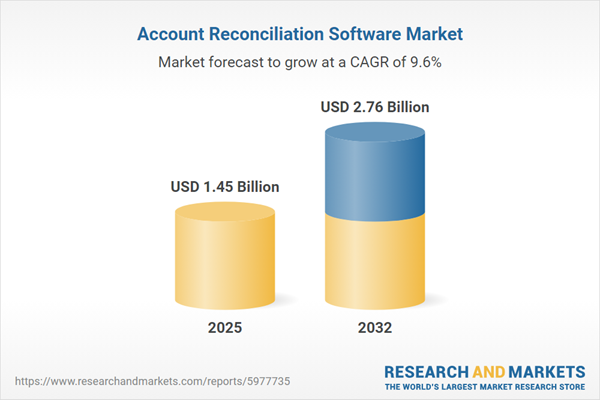Speak directly to the analyst to clarify any post sales queries you may have.
Account reconciliation software is rapidly becoming essential for organizations striving to maintain accurate, compliant, and agile financial operations. Senior decision-makers are leveraging these platforms to unify controls and automate processes, positioning their finance teams to adapt to evolving business and regulatory pressures.
Market Snapshot: Account Reconciliation Software Market
The global account reconciliation software market is on a trajectory of steady growth, reaching a projected value of USD 1.32 billion in 2024. Anticipated expansion to USD 1.45 billion by 2025 and USD 2.76 billion by 2032 corresponds to a compound annual growth rate of 9.59% during the forecast period.
This upward trend is driven by widespread automation in financial operations and more demanding regulatory mandates, with finance leaders actively modernizing reconciliation processes to replace manual workflows and strengthen compliance. Increased focus on real-time reporting and constant audit readiness is making account reconciliation software a critical foundation in enterprise finance transformation.Scope & Segmentation
- Components: End-to-end account reconciliation platforms are accompanied by support services such as implementation, management, advisory, and professional guidance. These elements help organizations maintain compliance-oriented financial operations.
- Deployment Modes: Solutions are available through cloud-based, hybrid, public, private, and on-premises deployments. This flexibility enables organizations to tailor their approach to meet distinct IT security and integration requirements.
- Organization Size: Software offerings are designed for both small enterprises and large organizations, with scalability that accommodates varying transaction volumes and evolving financial structures.
- End User Industries: Industry adoption includes banking, financial services, insurance, healthcare, IT, telecom, manufacturing, retail, and ecommerce. Each sector presents unique demands, influencing specific configuration and compliance needs in software selection.
- Applications: Core functionalities include automated record management, audit preparation, and compliance monitoring—addressing strict financial control and reporting standards.
- Regional Coverage: Vendors supply global and localized versions across the Americas, Europe, Middle East, Africa, and Asia-Pacific, adapting to local compliance codes, risk management practices, and industry expectations.
- Key Providers: Major industry players—BlackLine, Wolters Kluwer, Oracle, SAP, Fiserv, Workday, Workiva, Jack Henry & Associates, ACI Worldwide, and Linedata Services—are focused on extending features and supporting compliance for dynamic regulatory and operational needs.
Account Reconciliation Software: Key Takeaways for Senior Decision-Makers
- Cloud-native account reconciliation software allows finance teams to stay connected, maintain compliance visibility, and synchronize processes regardless of geographic dispersion.
- Integrated AI and machine learning reduce manual entries, enable efficient exception management, and deliver actionable insights that enhance ongoing reconciliation performance.
- Extensive customization and integration support promote seamless migration to digital finance models, sustaining operations through changes in regulation or organizational structure.
- Regional trends reveal varied priorities: North America emphasizes financial analytics and governance, Europe focuses on infrastructure linkages, while Asia-Pacific drives for strong data privacy and regulatory conformity.
- Vendors maintain strategic relevance through solution updates and close cooperation with users, enabling organizations to meet new regulatory and workflow challenges swiftly.
- Mid-sized businesses can adopt modular features incrementally, controlling costs while advancing automation and scaling operations to match future growth.
Tariff Impact: Navigating US Trade Policy Shifts
Adjustments in US tariff structures have prompted organizations to update cross-border financial management. Account reconciliation workflows increasingly incorporate adaptive compliance to address shifting regulatory demands. Algorithm-driven platforms support real-time procurement and payment actions, mitigating risk exposure and enhancing operational resilience.
Methodology & Data Sources
This report draws from executive interviews, industry roundtables, and focused analysis of regulatory and technological developments. Benchmarking and triangulation ensure the data is robust, equipping decision-makers with well-founded strategic guidance.
Why This Report Matters
- Empowers finance leaders to streamline reconciliation processes and face regulatory changes with responsive, sustainable strategies.
- Provides targeted guidance for aligning finance operations with broader organizational objectives in compliance and risk management.
- Offers clarity on how regulatory and technology factors shape efficient technology adoption and reliable period-end financial close management.
Conclusion
Advancing finance operations with account reconciliation software strengthens oversight, compliance, and adaptability, enabling organizations to meet evolving regulatory and business demands with greater confidence.
Additional Product Information:
- Purchase of this report includes 1 year online access with quarterly updates.
- This report can be updated on request. Please contact our Customer Experience team using the Ask a Question widget on our website.
Table of Contents
3. Executive Summary
4. Market Overview
7. Cumulative Impact of Artificial Intelligence 2025
Companies Mentioned
The companies profiled in this Account Reconciliation Software market report include:- BlackLine, Inc.
- Wolters Kluwer N.V.
- Oracle Corporation
- SAP SE
- Fiserv, Inc.
- Workday, Inc.
- Workiva Inc.
- Jack Henry & Associates, Inc.
- ACI Worldwide, Inc.
- Linedata Services S.A.
Table Information
| Report Attribute | Details |
|---|---|
| No. of Pages | 196 |
| Published | November 2025 |
| Forecast Period | 2025 - 2032 |
| Estimated Market Value ( USD | $ 1.45 Billion |
| Forecasted Market Value ( USD | $ 2.76 Billion |
| Compound Annual Growth Rate | 9.5% |
| Regions Covered | Global |
| No. of Companies Mentioned | 11 |









